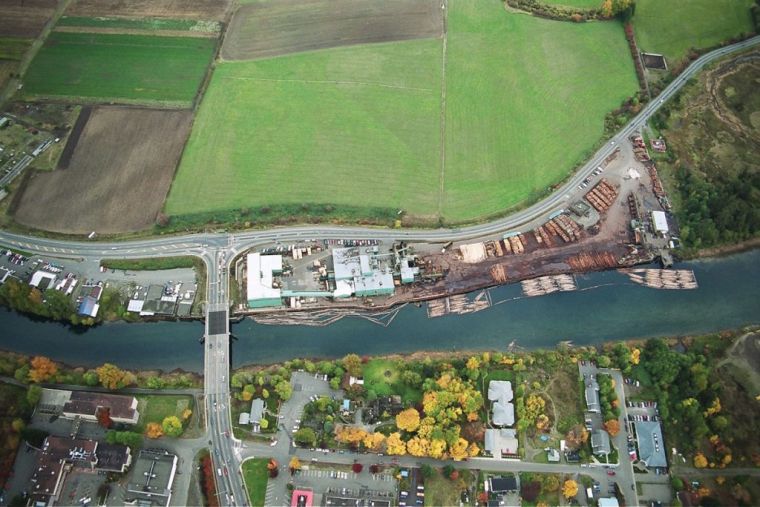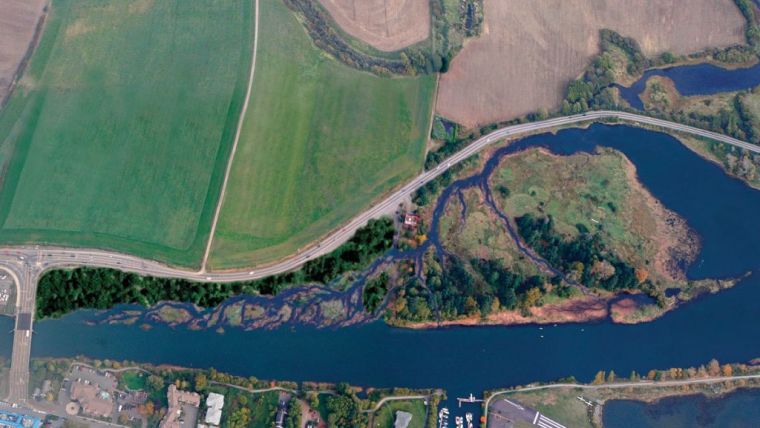Eco-Asset Action in the Comox Valley: A community prepares to unpave a parking lot and put up a paradise
Note to Reader:
The Comox Valley on Vancouver Island is facing a long list of challenges as more frequent and intense winter storms and summer droughts overwhelm engineered infrastructure and natural systems. In March 2017, the stewardship sector hosted a transformational event, the Comox Valley Eco-Asset Symosium. Sponsored by the four local governments, the theme for this ‘watershed moment’ was Discovering Nature’s Infrastructure Potential.
The excitement and energy generated by the Symposium has helped to move forward the long-term vision for transforming a decommissioned sawmill site on the Courtenay River into a valuable habitat corridor that could also transform the city’s most troublesome flood liabilities into an eco-asset corridor for the whole community.
The salmon-bearing Courtenay River flows through the City of Courtenay into the K’omoks Estuary, Baynes Sound and the Salish Sea. Project Watershed’s inventory of more than 40 potential projects for the K’omoks Estuary identified the 3.5 hectare sawmill site as a key area of damage and top restoration priority. It is situated adjacent to the protected Hollyhock Marsh.
Project Watershed is leading the local community in a historic effort to restore this important ecological site and salmon habitat in partnership with the K’omoks First Nation and the City of Courtenay. Each project partner and the community at large has come together to learn and share the many benefits of watershed restoration.
Kus-kus-sum Restoration on the Courtenay River Connects Eco-Assets to the Power of Community Partnerships and Storytelling
As part of the Comox Valley Youth Media Project’s latest documentary series Food for Thought, 16-year-old filmmaker Jessica Speck created this short video exploring the many positive impacts of the groundbreaking Kus-kus-sum initiative to “unpave paradise”.
Tranformative Action Through Storytelling Galvanizes Community
“The Comox Valley is approaching a watershed moment in land restoration, and all of British Columbia can learn some important lessons here,” states Vanessa Scott, writer and community organizer volunteering with Project Watershed.
 “Last fall, Project Watershed launched its public campaign to purchase and restore the sawmill site on the Courtenay River. Renamed Kus-kus-sum to honour K’omoks First Nation’s historic uses of the area, this is the most ambitious restoration initiative in the history of the Comox Valley. It showcases the combined efforts of many watershed champions.
“Last fall, Project Watershed launched its public campaign to purchase and restore the sawmill site on the Courtenay River. Renamed Kus-kus-sum to honour K’omoks First Nation’s historic uses of the area, this is the most ambitious restoration initiative in the history of the Comox Valley. It showcases the combined efforts of many watershed champions.
“Whether motivated by the return of healthier salmon runs, the cultural and territorial recognition of the K’omoks First Nation, or the reduction of flood risks and preparation for climate change, everyone in the community has a story reflected in this inspiring project.”

The site when it was a sawmill operation (photo credit: Dan Bowen)
Collaborate, Connect Dots and Create Synergies
“At the Nanaimo Water Stewardship Symposium in April 2018, an event which was inspired by the 2017 Comox Valley Eco-Asset Symposium, many critical themes emerged which the Kus-kus-sum story brings to life. The Nanaimo Symposium provided a platform and call for action that adapting to climate change requires transformation in how we value nature and relate to the land,” continues Vanessa Scott.
“If we are to achieve any meaningful level of sustainability, all development has to be not only sustainable, but restorative,” said keynote speaker and author Bob Sandford, who also headlined the Comox Valley event. “We face so many overlapping and intersecting crises we can no longer afford to fix them one at a time or in isolation of one another. All future development must seek double, triple, if not quadruple benefits in terms of the restoration….”
Pilot for a National Initiative:
“From the City of Courtenay’s perspective, Kus-kus-sum delivers exactly this convergence of multiple opportunities and risks to drive municipal interest in the project as an ‘eco-asset’ restoration,” observes Vanessa Scott. “Such a science-based and policy-driven conversation requires many parties and flows naturally from the successful Eco-Asset Management Symposium held last year in Courtenay in partnership with the Comox Valley Land Trust, Partnership for Water Sustainability in BC and Project Watershed.
“As a feature of the City of Courtenay’s updated floodplain management plan, Kus-kus-sum has been selected as a pilot project in the Federation of Canadian Municipalities’ Municipal Natural Asset Initiative (MNAI) as an innovative way to “address the twin problems of ageing infrastructure and ecosystem decline.” The sustainable service delivery implications of achieving flood attenuation, by using green infrastructure to protect private and public built infrastructure, is also a case study in providing a buffer for future extreme events and climate change.”
Moving Towards Restorative Development
“As we learned at the Nanaimo Water Symposium, anecdotal evidence suggests that BC is beginning to experience a public groundswell of heightened energy and awareness of the watershed context. Through flagship projects like Kus-kus-sum, we are learning how this awareness translates into greater public advocacy and empowerment.
“Projects like this which combine the ingredients for policy action with an inspiring community-led vision — create space and a mechanism to engage communities in big picture values. Led by wild salmon and local passion, Kus-kus-sum is advancing a common agenda with key partners and highlights how public engagement and storytelling is a key driver underlying restoration,” concludes Vanessa Scott.

What the sawmill site would look like after transformation into Kus-kus-mus (image credit: Robert Lundquist)

